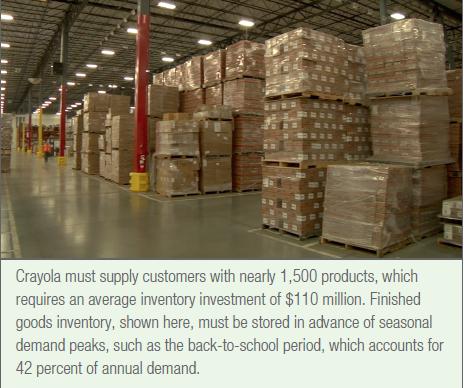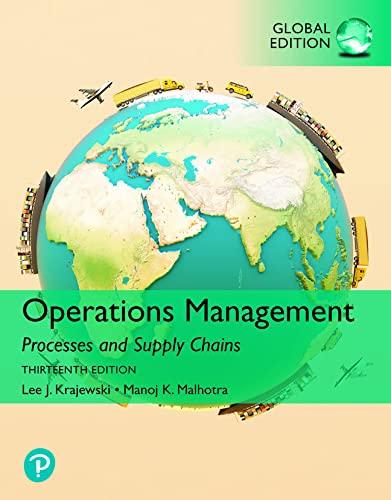Managing inventory at Crayola is a fine balancing act. With the back-to-school period driving 42 percent of
Question:
Managing inventory at Crayola is a fine balancing act. With the back-to-school period driving 42 percent of company demand for crayons, markers, paints, modeling compounds, and other products, production starts in February so enough finished goods are in the 800,000-square-foot warehouse in time to supply 3,600 Walmarts, 1,400 Targets, and thousands of other retailers in the United States for the fall school-supply rush.
This means demand forecasts for raw materials in the master production schedule must be developed months before any of the finished products move to those retail customers. Lead times range from 60 days for domestic raw materials sources to upwards of 90 days for finished goods from suppliers outside the United States. As production ramps up for the back-to-school season well before the first day of classes, Crayola plans inventory levels for the entire year so that production remains reasonably steady. While the back-to-school season represents the lion's share of annual sales, holiday sales account for 35 percent of revenues, and the rest comes from spring sales. Crayola has over 1,500 SKUs, with close to 225 top sellers, so accurate forecasts are essential. Historical sales patterns as well as orders generated by its U.S. sales divisions located in Easton, Pennsylvania (headquarters), Bentonville, Arkansas (near Walmart's headquarters), and Minneapolis, Minnesota (near Target's headquarters), help managers attain the accuracy needed. Marketing cobranding for the latest movies and comic books plays a role in creating the forecast for new SKUs and bundles, which must be coordinated to hit retailers the same time the movies and comics debut or the company risks missing the market and ending up with inventory that can't easily be sold. Crayola's inventory holding costs run about 25 percent, and its average inventory value is $110 million. The company must ensure there is warehouse space for finished goods as well as raw materials used in production. Pigments, clays, and packaging materials are moved from the warehouse and positioned close to the production lines, using a Kanban system to pull raw materials inventory as needed. Rail tanker cars from Louisiana and Pennsylvania carrying paraffin wax are delivered twice a week for crayon production. Since the rail cars feed directly into production, any disruption in delivery has the potential for shutting down production. Bad weather is a particular risk in this part of the company's supply chain, since it can prevent the transport of goods during hurricanes or snowstorms. Crayola attempts to source as many raw materials from domestic sources as possible. Cartons, clay, ink, labels, and corrugated boxes come from the mid-Atlantic region of the United States, while those plastic components Crayola does not manufacture onsite, such as nibs for markers, are sourced from Asia and can take up to 120 days to ship through the Panama Canal to the Port of Newark. Materials used in kits and bundles come from Korea, China, Vietnam, and Brazil, and face similar shipping logistics. When considering work-in-process inventories at Crayola, paints, markers, modeling clays, and many of the crayons coming off the production line are boxed into trays for use downstream in creating kits and bundles. These items are considered WIP items, even though the individual units are finished goods (i.e., a crayon or marker is completely manufactured once it comes off the line). The same is true for marker barrels, paint pots, and other plastics. Specialized equipment is used to make these items, which feed downstream production. Recently, Crayola's leadership expected that actual demand for its popular Marker Maker© toy product might come in higher than the original forecast. As a countermeasure, Crayola established duplicate capacities in China and the United States to meet the aggregate potential demand. In China, the company produced the original forecast and delivered to customers as planned. However, when the actual demand was 26 percent over the original forecast, Crayola could meet the surge in demand because it had positioned the long lead time ink bottles in its Pennsylvania plants and was able to mold the plastic parts using marker components from its core marker product. By utilizing existing machine capacity in its plants, reducing the lead time of ink bottles by making them in Pennsylvania, and by duplicating tooling, Crayola was able to ensure that its customers and consumers were satisfied during the holiday season.
QUESTIONS
1. Consider the pressures for small versus large inventories. Which situation does Crayola seem to fit, and why?
2. Explain how both independent and dependent demand items are present at Crayola.
3. The Marker Maker© product recently experienced an unexpected surge in demand and the supply chain's agility was credited with helping to meet the crisis. We have discussed four ways to classify operational inventories by how they are created. Regarding the ways managers can use these inventories to satisfy demand, explain how Crayola can achieve the flexibility to adjust to unexpected demand surges.
Step by Step Answer:

Operations Management Processes And Supply Chains
ISBN: 9781292409863
13th Global Edition
Authors: Lee Krajewski, Naresh Malhotra, Larry Ritzman





